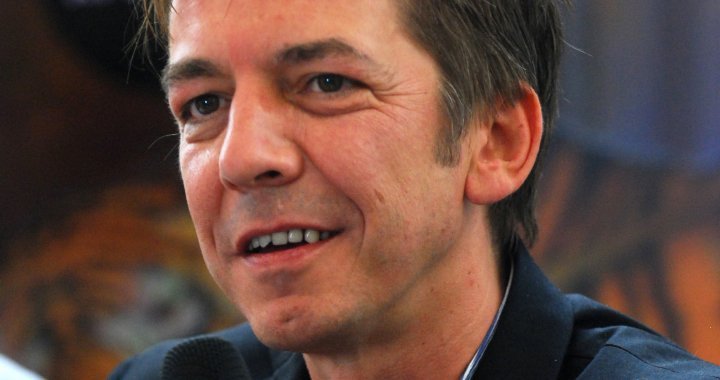
“I Find My Freedom In That Which Isn't Written Down”
An interview with Belgium's Carll Cneut, illustrator of children's books
Agnese Čivle
23/12/2014
Children's book illustrator Carll Cneut (1969) currently lives and works in Ghent, in the north of Belgium. It is where he finished his studies in graphic design at the Sint-Lucas Beeldende Kunst art school, which then led to his work in graphic design for advertising. It was only due to pure chance that Cneut tried his hand at illustrating children's books. At the start of the new millennium, illustration had already become Cneut's main genre of work – by now he has created twenty books, and is internationally renown in Belgium, the Netherlands, Italy, France, Slovakia and elsewhere. In 2012 Cneut was one of five finalists for the Hans Christian Andersen Award, and in both 2014 and 2015 he was nominated for the Astrid Lindgren Memorial Award.
Carll Cneut currently works as an instructor at the Royal Academy of Fine Arts in Ghent (Koninklijke Academie voor Schone Kunsten), where he teaches the art of illustration.
Mainly working with pencil, ink, acrylics, oils and pastels, Cneut creates illustrations that are saturated in color and rich in texture, with a kind of patina that gives them a vintage look. Besides his most notable signature features – dynamic compositions and generous use of the color red (now commonly known as 'Cneut-red') – Cneut's works also distinguish themselves with their unique ability to bring the reader into the emotional world of the characters. Although you will never see the characters' faces straight-on, nor look them straight in the eye, their body-language alone makes you feel as if you're experiencing everything right along with them.
On December 2 of this year, Belgium's largest-ever exhibition of Carll Cneut's works, “Carll Cneut. In My Head”, opened at the St. Peter's Abbey gallery (Kunsthal Sint-Pietersabdij). Along with displays of his books and approximately one hundred original illustrations, the exhibition is set up in a way that brings to life the fantasy world, characters and milieu that Cneut has created through his art. In the center of the exhibition is a specially-built studio for Cneut, and visitors are be able to watch live as he goes about his work. A separate room displays Polaroid pictures that Cneut has taken over the years, for these give a glimpse into his daily life. “People in Belgium still believe in this romanticized idea that the illustrator lazily begins his day at around 10:00 am, unhurriedly sips his morning coffee, maybe takes a shower, and then, still dressed in his pajamas, sketches something for a couple of hours – so that he can spend the rest of the day doing nothing... You see, as a maker of books, my life is quite different than the one I just described. I work with discipline in my studio or at school, from 8:00 to sometimes even 7:00 pm. At other times, I must travel for work...”
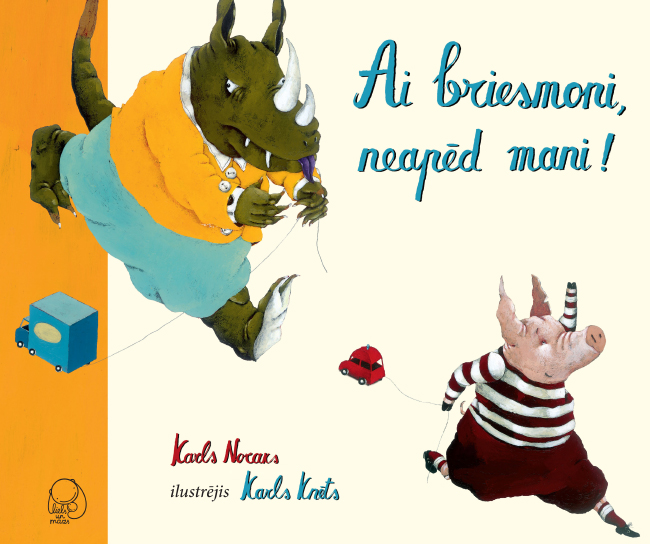
The cover of the book “Monster, Don't Eat Me!”
At the beginning of November, Carll Cneut came to Riga for the release of the Latvian edition of the book, “Monster, Don't Eat Me!”, by Flemish author Karl Norac. Cneut revealed to Arterritory.com that this is one of his favorite books, and that he put much of himself into the book's illustrations: “When I was small, I was rather portly... When I read this story for the first time, I had nearby this picture of me – small and chubby, and I was wearing a brown striped sweater, just like the main character of this book. It was precisely this photograph that inspired my depiction of this character.”
Alex, the main character in the book, always pulls along a small red toy car, while the monster has a little blue truck. The illustrations have a lot of tiny, even minuscule, details; the images are rich and full of activity. “You have to look very carefully to take it all in. But children notice it immediately!” says Cneut.
Since you've been creating illustrations for children's books for seventeen years now, it would, of course, be interesting to find out more about your own childhood. What was it like?
I was a boy from a farmhouse. Practically nothing happened in our small town on the Belgian-French border, and it was nearly impossible to come into contact with art. Nevertheless, I was really interested in it! I was still a little boy when I began to collect illustrated books that my parents would order through the mail. I also remember taking part in a Belgian pasta company's rewards program – you earned points for every package purchased, and once you had enough points collected, they'd send you a reproduction of a famous painting. Accordingly, I would eat tons of spaghetti! I had a happy childhood. I was good at school, as well as later at my university studies, which is why my parents imagined that I would have a serious career in law or something like that...
So you had to convince them otherwise...
I studied Latin-Greek philology, and usually it is assumed that everyone who studies this goes on to become a lawyer or something like that. Yes, I had to persuade them of the fact that I wanted to work creatively – and I had already discovered the opportunity to study graphic design in Ghent.
Later on, I began work as a graphic designer and creative director at advertising agencies. It was only pure chance that I was asked to help somebody out by drawing three illustrations. These were followed by more, until I was offered to illustrate a whole book.
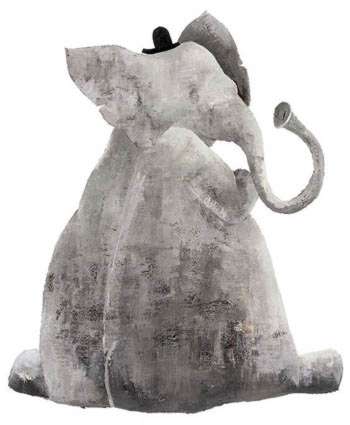
Willy. © Carll Cneut
What was the very first book that you illustrated?
The first book was a collection of verse titled “Marzipan Piglets” (Varkenjes van Marsepein, 1996). Actually, books of selected poems were the first three books that I illustrated. I wouldn't say that I really enjoyed illustrating this specific genre, but the fourth book was already a story – a story about a little elephant called Willy (Willy, De Eenhoorn, 1999). I understood that that was something that I really enjoyed – I like to participate in the authoring of the story. In 2000 I was given an award in Belgium, and I had officially become an illustrator. That's how it happened!
I understand you've also tried your hand at writing...
I published my story, “The Amazing Love Story of Mr. Morf”, in 2000, with Macmillan Publishers in England. Perhaps I was still too young at the time, or too stupid, to understand how it all should have been done... The publishers were very critical regarding the text. Back then I didn't yet understand how to illustrate my own text, and I also didn't know how to defend my ideas; in the end, the book turned out different than I had imagined it. But it was a valuable experience – I now understood that creating a different illustrative interpretation of a story that you've written yourself is not that easy. It's much easier to create a visual interpretation of stories that others have written.
Tell me about the dialog that is created between the author of the text and the illustrator – this creative synergy!
I only work with authors who are willing to trust me – to hand the text over to me, and to let me do my job. In truth, there isn't any special communication or conforming going on between the author and me – although it's not as if I don't listen to the writer at all.
Sometimes things turn out completely differently than the author had expected, such as with my illustrations for the book “One Million Butterflies”. The story is about a boy who feels butterflies in his stomach for the first time. When I first read it, I noticed that nowhere is it mentioned that the character is a human. So I created a story about a little elephant that feels butterflies in his stomach for the first time! The author was in shock... Yes, we had a bit of a discussion about it, but the result was an even better book! The story had become much broader and universal; it was no longer about a boy and a girl with butterflies in their stomachs – it was now a fun story about an elephant boy and an elephant girl with butterflies in their stomachs! I believe that things that are not implicitly stated in the text, nor especially pronounced – that is my, as an illustrator's, freedom.
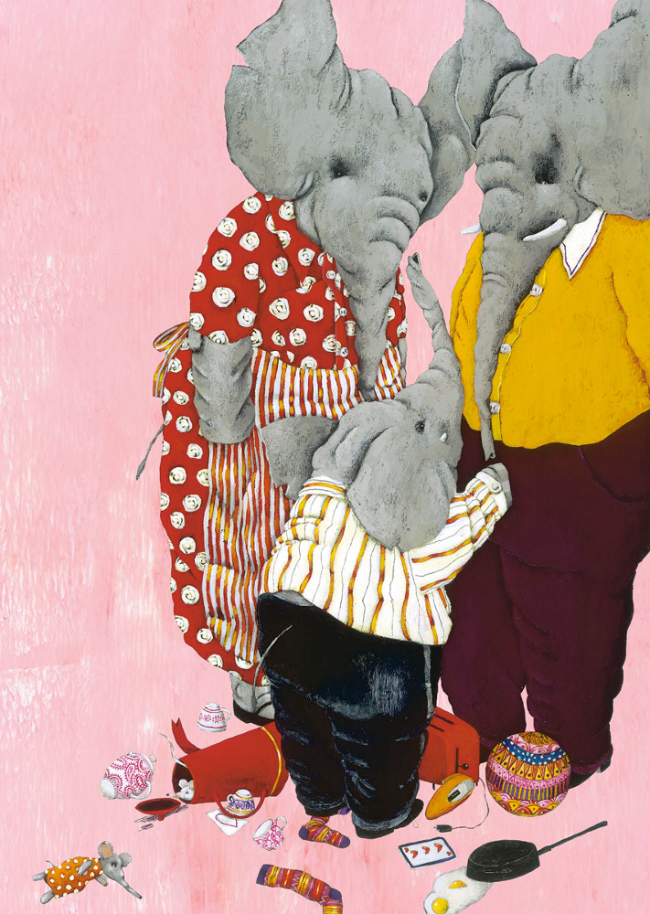
© Carll Cneut. Illustration for the book “One Million Butterflies”
And where is there room for the reader's freedom?
The freedom of the reader is very important to me. I always try to leave space between the text and the images – space that the reader should fill in him- or herself. The end result that makes a book a good book is a combination of all three – the text, the images, and the reader's imagination. I don't have anything against books in which everything in the text can also be seen in the illustrations, but that's simply not what I want to do. In my view, there are as many versions of the story as there are readers.
Do you feel a sense of responsibility towards the readers/viewers of your books?
Yes, of course. If someone has bought my book, I'm responsible for making the person want to read it more than just once. And this book should stimulate the reader's imagination and sense of fantasy.
The point of illustrations is to encourage reading, to encourage the use of one's imagination... What else?
To broaden children's thinking. So that children have a broad view of things, so that they are open to, and interested in, the world. That is my objective.
How do you 'meet' your characters? How do they come about?
It simply happens. I read the story and then I let the characters grow in my head for a while. Actually, I don't think about it a lot; I simply do it, and I couldn't have done it any other way. In addition, I get the feeling that I simply must do it!
My job – it is completely me, myself. I believe that in order to do this job, one must be absolutely honest and true to oneself. The second you're not, the children notice it, and the books won't be bought. This once happened to me – I illustrated two books for completely the wrong reasons. Well... for the money. And I allowed the publishers to meddle in my work. Although they were rather commercial stories, they didn't sell, and they are my two most commercially-unsuccessful books. It was amazing – the children sensed that there was something wrong in them...
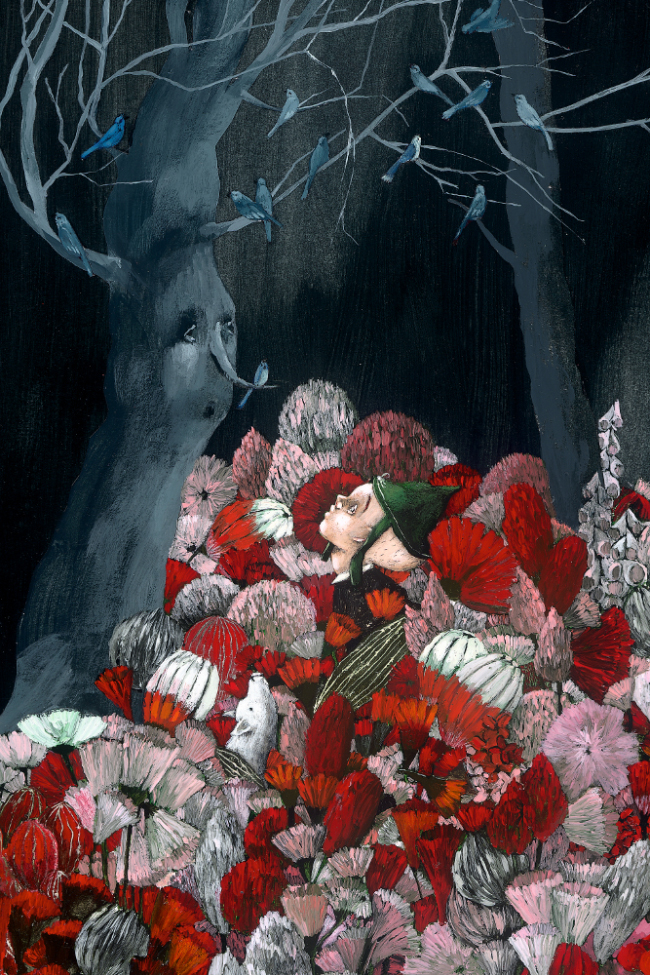
© Carll Cneut. Illustration for the book “The Blue Bird”
When drawing your characters, do you try to identify with them? Are they, in some sense, a reflection of your own character?
Possibly, yes! Every time I draw an angry character, an angry expression takes over my face as well. If I'm drawing a funny character – I smile. Yes, I do have the feeling that there is some connection between me and the character I'm creating. And I like to draw piglets... That probably says a lot about me! (Laughs)
There's this hungry piglet, Alex, from the Latvian book...
You know, my greatest fear in life is to experience hunger! I don't know why that is. I've always had enough to eat, but, for instance, if I'm going somewhere, even if I know that there will be many shops there, I take along food. But only to be on the safe side... (laughs). Just to be safe, there's always some food in my baggage!
Do you remember all of the characters you create, or do you forget them over time?
I remember them all. Maybe some I'd like to forget... But I remember them all because I've drawn them from the heart. I've created about 20 books over 17 years; maybe that's not that much, but I do remember them.
How has your work changed over the years?
Now I'm better at drawing! When I started illustrating by pure chance, I don't think I drew all that well; I could only draw what I knew how to draw. After all of these years of drawing day after day – I don't feel as limited anymore. The whole process has become much slower and more time intensive, however. At first I painted with large brushes; now I use the smallest ones I can find. Technically, my work has become more refined – more colors, more layers... The original illustrations are very different from the printed ones. If you saw them, you could feel their texture.
What is the most important thing about your characters – their physical poses, their facial expressions...?
In my case, it's their poses because I don't use facial expressions much. Actually, there almost aren't any. Instead, the character has taken a pose that expresses, for example, anger. In illustrating animals I may do this less, but when I illustrate people, I use this technique to create a kind of distance. This is exactly what allows readers to feel as if they're in the character's shoes, and that they're part of the story. In addition, I usually depict human characters in profile. Usually the characters in illustrations look at you, but mine don't. People usually don't even notice this, but just go leaf through my books – the characters are not looking at you!
Do you tend to frame the originals of your illustrations as separate artworks?
I don't do that, but people like it. Consequently, I receive requests to sell my works. Sometimes I do sell something, but mostly I want to keep them myself. I do, however, tend to exhibit the originals.
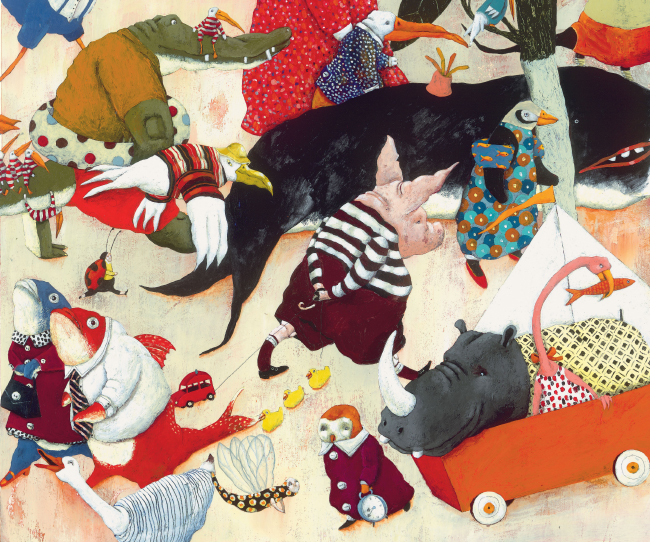
Illustration for the book “Monster, Don't Eat Me!”
I once heard it said that illustrators answer questions through their work, whereas artists pose questions through their work. Do you agree?
I have no idea. I look upon myself as more of a master of my craft rather than an artist. I create objects that are, in truth, commercial – they are designed from the start to sit on shop shelves. I am a craftsman who constructs books, who tries to make them interesting. I put all of my heart and love into this work, bet there is still no big difference in whether it is a good book that has been created, or a good pair of shoes. I'm not too fond of it when book creators begin to contend as artists. That's not who we are.
But people call you an artist anyway...
I don't care about that. I want to be a creator of books. Also, if I participate in an exhibition, the exhibition ends up explaining how books are made. If people want to see it differently – well, that's not a problem.
Tell me about you working environment, your studio.
I work at home, on the ground floor. The house is located in the medieval part of the city, and the large studio window looks out on the canalside with its trees. The waterside is a very popular place for walking and jogging, and every day I can people-watch. Sometimes it's a great source of inspiration.
Can we spot in your characters people from the canalside?
One of the characters from my earlier books is a plump woman... Back then, every day at around twilight, a – let's say, plus-sized – woman would come to the canalside. Time passed, and her jogging along the canal was obviously doing her good – she became thinner and thinner. After a year and a half, by which time she looked really good, I stopped her one day and spoke to her. I explained that she had become a character in my book – back when she had just started her exercise routine, and I gave her a copy of the book. She was happy and laughed, even though she was depicted as being very large in the book... But back then, she really was!
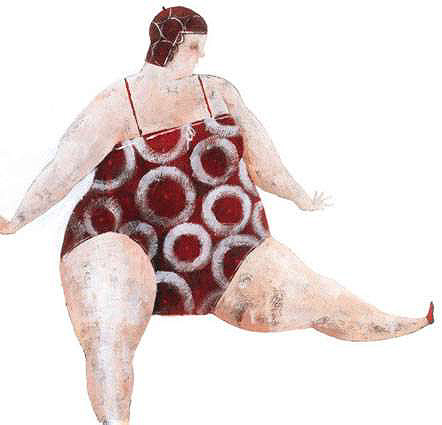
© Carll Cneut
What about inspiration coming from art?
I find great inspiration in the classics! From Rubens, Bruegel, James Ensor... I'm also inspired by some Belgian contemporary artists – usually precisely because of their technical execution.
But mostly, it's just daily life. You see, I think my mind works a bit differently than most people's. I remember everything I see. If you ask me what I did yesterday, I'd have to think about it – maybe even for 20 minutes! But if you ask me what I saw yesterday, I'll tell you without giving it a second thought!
If someone would ask me what is going on in my head, I'd say that it is like a chest with drawers that are full of folders that contain images. When I begin a book, all I have to do is find the characters among these folders.
You've illustrated books that originate from various countries. Have you noticed which themes are typical for individual countries? Or, are there any subjects that are purposely avoided?
Some countries are very open to an array of themes, such as France. Germany is a very complex country, while England and the US are very traditional. Italy was very traditional, but now it is very open. It changes...
In Flanders, children's books can be about anything – illness, death, suicide... anything! But in the Netherlands, where they speak Dutch just like in Flanders, the range of themes found in children's books is very narrow. I come from Flanders in Belgium, and children's books there used to be very commercial, telling only happy stories; but 15 years ago, the situation changed drastically... This was, in large part, thanks to De Eenhoorn publishers. They began to publish different kinds of books, and although all of the big publishing houses made fun of De Eenhoorn's books in the beginning, now they all follow De Eenhoorn's example. De Eenhoorn changed the way publishers approach children's books, and now our bookstores have everything – both commercial children's books and the kind that invite discussion. For example, if parents are divorcing, then in our stores you can find books about divorce, and use them to explain the situation to children. This is a great to thing to have! I don't have anything against 'light' and commercial books, but it's wonderful that there are books for various situations – such as when you need the child to have some quiet time, or when you need to discuss delicate or complex issues with the child. Belgium has a high suicide rate, and it's good that we have books that explain this issue. Publishing houses' approach to the needs of society has changed.
You also work as an instructor. What have you learned from your students?
So much!
I've taught for seven years, and I love this job. I try to be as good a teacher as I can. And I must say that I get just as much energy back from the students. My students keep me alert and don't let me loose my edge. Even though I wish all of my students great careers, I still want to be better than them! I was once nominated for an award in Belgium; I usually don't pay much attention to awards, but this one I just had to get because some of the other nominees were my students. And I won! (Self-consciously chuckles.)
What advice would you give to young book illustrators?
Always be nice to whomever you meet on your journey because you never know where you might meet them again!
I believe that if you really want something, you can do it; but you have to really, really want it. I've known illustrators with big ambitions, but you have to take advantage of all of the chances that come your way. I've worked hard for things to be the way they are now. It's always an investment of time and work; and when you start – it's for just really small amounts of money.
What's the best thing you've gotten out of your work?
Sometimes I get letters and drawings from children – that makes me happy. Even though I don't know these children, just seeing how they have been inspired by my drawings, and how they have felt the need and enthusiasm to draw something – that makes me very happy.
Before I left for Riga, I received a thick envelope from a small girl named Anne Marie. She had been inspired by my latest book, “The Golden Cage” (De gouden kooi), and the envelope was full of pictures of birds that she had drawn!
I also teach creative workshops for children. Maybe because that was something that I lacked when I was still a child... My father drew well (at least how I remember it), and every evening before going to bed, we would draw Mickey Mouse together. Every evening! He died when I was very little, however – I was seven – and after that, no one drew together with me anymore. I really missed that. Perhaps that's one of the reasons why I love my job so much...
Sometimes I wonder what my life would be like if I hadn't persuaded my family that I want to study graphic design instead of law. I'd probably be a very bad lawyer.
facebook.com/carllcneutillustrator
users.telenet.be/carllcneut